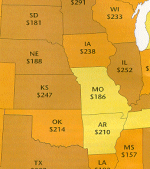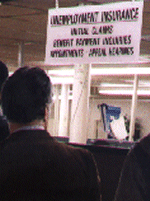
Related Stories

Reforming Unemployment
International President Tom Buffenbarger
says that state governments need to take a hard look at their unemployment
insurance systems to make sure they are doing the job.

Unemployment Insurance: More
than just a benefit
Unemployment Insurance Stops Recessions from becoming depressions.

Unemployment Insurance:
Will it pay the bills? A laid off IAM member's experience.

Different flavors of unemployment
Understanding the causes of unemployment is vital to combatting it.

Using Unemployment as a Weapon
Employers have traditionally used unemployment to drive down wages, divide workers, and undermine unions.

They call this 'wage insurance?'
A look at the avearge weekly UI benefits by state and projected solvency of state UI trust funds.

Resources & Contacts
How you can help effect unemployment reform.
Get the Video
Order "Reality Checks" a free IAM-produced video that explores the current state of the nation's unemployment insurance system.
Email your order to IAM Communications
Director Rick Sloan at rsloan@iamaw.org
or call the ommunications Department. 301-967-4520.

Reality Check #4
UI Failing Full-timers, Too
UI is failing millions of traditional full-time workers, not just part timers and the poor.
Only 38 percent of the unemployed receive UI benefits today (compared to 50 percent in 1950), and fewer than half of those eligible even bother to apply!
What is going on? Declining union membership is largely to blame, according to a recent report to the Department of Labor. Unions keep workers informed about UI and often assist in filing claims. Non-union workers are often laid off with no information or guidance at all.
New restrictive state laws
have also spawned red tape and confusion. The report found 53 percent of
the workers who failed to apply for UI said they didn't apply because they
believed (often, incorrectly) that they were ineligible for benefits.
Reality Check #5
Tottering Trust Funds
At first blush, the UI system seems
healthy enough. The 50 state trust funds that issue benefits checks seem
to have worked exactly as they were designed to. During the past nine years
of low unemployment, the funds added $18 billion to their reserves, swelling
56 percent to a current total balance of $50.3 billion.
Appearances can be deceiving: the combined, national figures conceal far more than they reveal.
Yes, some states acted responsibly, socking away funds during the business expansion to pay for future benefits. Others squandered the boom years by "competing with other states for the biggest UI payroll tax deductions," researcher Marc Baldwin wrote.
This race to slash employer taxes (driven by corporate lobbyists) siphoned $47.7 billion from the UI system in the past seven years, alone: close to the current combined total of all UI trust funds, nationwide.
The result: a UI system so
underfinanced that many state funds would collapse in even a modest recession.
Reality Check #6
Could UI Go Belly Up?
There are two widely accepted ways
to measure the health of UI trust funds, but the picture is disturbing
whichever one you use.
The most lenient measure (and the one most commonly used) is the "Average High Cost Multiple." The AHCM is like a 20-year storm. It asks, "How many months could the fund pay benefits, if the state faced the worst recession of the past 20 years?"
The recommended AHCM is 12 months. The average for all U.S. state trust funds is only 10.3 months. The trust funds in five states would go bankrupt after only five months of recession.
A tougher standard is the High Cost Multiple, or HCM, which is more like a 100-year storm. The HCM asks, "How many months could a fund pay benefits if the state faced its worst recession on record?"
The average HCM for all U.S. trust funds is less than 8 months, and the five states with the highest current levels of long-term unemployment would see their funds go belly-up after only 18 weeks!
"It is troubling how few
states are prepared for sustained, deep recession, or in the case of a
handful of states, even a shallow economic downturn," Baldwin warned.
Reality Check #7
Betting Your Benefits
Will we be tested by the sort of
"sustained deep recession" that worries Marc Baldwin?
Many economists say, "No." They insist the U.S. has entered a new economic age, where high unemployment and deep recessions are problems of the past.
The economists were so confident, states replaced the tough HCM standard with the more relaxed AHCM, allowing UI trust funds to operate on far leaner reserves.
They were so confident, in other words, they bet your benefits!
However, there is mounting evidence the economists had it wrong; that a "sustained, deep recession" -- or worse -- may already have begun.
Only 12 months ago, the U.S. was riding the longest wave of economic growth, low-unemployment and low inflation in more than 40 years.
But 2001 opened in a blizzard of pink slips: a record-high 6,182 layoffs a-day during January, and it got worse from there.
By March, the economy had shed 572,370 jobs -- triple the rate of job loss for the same three-month period the previous year.
By the end of June, the number
of new claims for jobless benefits hit levels not seen since the depths
of the 1990-92 recession. The circle of damage now extended well beyond
manufacturing to white collar professionals, "dot commers" and service
trade employees.
Reality Check #8
A Perfect Storm
So far, we are seeing the early stages
of a typical recession. Businesses are laying off, cutting back on purchases,
investments and new construction, feeding a chain reaction of cutbacks
and layoffs by other employers. As sales and profit margins shrink, stock
prices tumble and consumer confidence declines, further cutting demand
and spurring more layoffs.
But this slow, downward spiral could take a very nasty turn. The current downturn appears to be converging with a number of negative long-term economic trends -- much like the weather fronts that merged with such deadly effect in the film The Perfect Storm.
Consumer buying power is essential for economic growth. Yet, the annual incomes for 60 percent of all U.S. families grew only 3 percent between 1979 and 1999, according to a report by the Financial Markets Center.
So far, the U.S. has escaped the effects of stagnant consumer buying power thanks, in part, to decades of government deficits. The federal government stimulated demand, year after year, by pumping trillions of borrowed dollars through the economy.
Those days are over. For the first time since 1969, we have a federal budget surplus.
Record-high levels of business and personal debt also helped stimulate the economy through the 1990s, but that trend may be over, too. Limited earnings cannot support unlimited debt. At some point, you hit the wall and when you do, traditional tools for stimulating demand -- cutting interest rates, for example -- become increasingly less effective.
The U.S. was lucky to have healthy partners in Japan and Europe to pull us out of the 1990-91 recession. But who could pull us out today?
Japan is near financial meltdown, according to its own foreign minister. Stuck in a decade-long recession (aren't sustained recessions a thing of the past?) Japan has recently entered a deflationary spiral -- a code word for an economic depression.
The economies of Europe are also weak, as are those of Mexico and Canada.
What happens to them if the United States slides into recession? As the world's leading debtor nation, the U.S. bought $499 billion more in goods and services from our partners than we sold overseas. Who will buy all that stuff if the U.S. economy tanks?
It is easy to see how a shock
or series of shocks -- a depression in Japan; a Mideast war; a sudden spike
in the price of oil -- could send the new global marketplace into crisis.
Reality Check #9
IAM Agenda For UI Reforms
The battle for decent wage insurance
is part of the larger battle for a high-wage economy, just as the undermining
of UI is part of the battle to drive down wages. (See Page 17). Decent
benefits allow people time to seek out jobs with decent wages, benefits
and working conditions.
Low (or no) benefits and restrictive laws force the unemployed to take a job, any job, simply to survive. That's the path to a "low-wage" economy.
To achieve a "high wage economy" the IAM Platform calls for boosting employment and wage rates through "an effective plan to stabilize and provide full employment...to shorten the hours of work to thirty per week."
Reforming and revitalizing the UI system itself must start now. And there are specific steps that all states should take:
. Provide complete and adequate
wage protection for women as well as men, and eliminate discriminatory
provisions from state UI laws.
. Amend state laws to provide
adequate wage insurance to low wage and contingent workers.
. Set minimum UI benefits
(with supplements for dependent children) to keep recipients and families
out of poverty.
. Amend the 26-week limit
on benefits in most states and the formulae that "trigger" extended benefits
on and off. Benefits should be paid for much longer periods of time and
extended benefits should be issued to states and maintained, as needed,
without any waiting periods.
. Adopt "alternative base
periods" that establish an individual's eligibility based on earnings for
the last five complete calendar quarters. Current, more limited base periods
harm low-wage workers who need every penny counted to satisfy minimum earnings
requirements.
A determined effort to guarantee the solvency of the UI system is also needed.
Trust funds went bankrupt in 22 states during the early 1980s, costing taxpayers hundreds of billions of dollars, as states were forced to borrow from the federal government to pay for UI benefits.
Ironically, the states made the problem worse with laws making it harder for people to collect. The UI system is financed by taxing employers according to the number of people they lay off who wind up drawing benefits. Fewer people collecting means less revenue flowing to the funds.
Part of revitalizing UI, then, is to roll back the restrictive laws passed in the 1980s, particularly in those states with healthy trust fund reserves:
. Trust funds in 27 states
are in reasonably sound condition, with at least 12 months benefits on
hand, assuming the worst recession in the past 20 years. These states should
amend their laws to reflect the needs of the modern day work force, repeal
restrictive regulations enacted since the 1980 and take decisive steps
against structural unemployment.
. Nine state trust funds
could quickly face a crisis in an economic recession. Although they have
less than 12 months benefits on hand, they pay benefits to at least 38
percent of their jobless workers -- above the national average. Moving
swiftly to build up their reserves, perhaps through a permanent UI tax
hike on employers, would be a first step.
. Fourteen states wear a
badge of shame. Their funds are dangerously underfinanced and they pay
benefits to a below-average number of jobless workers. They must overhaul
their UI systems, top to bottom, make benefits more accessible to more
workers and pump money into their funds.
No states are truly prepared for a severe economic downturn. The most accepted solvency measure (the Average High Cost Multiple) is way too lax. Soon, the AHCM's "20-year standard" won't even cover the 1982-83 crisis that bankrupted UI funds in nearly half the states!
States should return to the safer High Cost Multiple and measure solvency by the worst recession on record.
A decent insurance policy has rules that are clearly spelled out and fairly applied. It is properly financed to provide adequate benefits promptly when help is needed.
Our current Unemployment
Insurance system fails miserably on all counts, and millions of workers
are already paying the price. Without serious state-by-state reforms, we
all may pay an even higher price when the tough economic times roll around
again.
Back/Contents